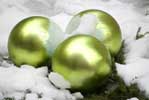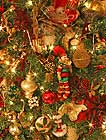Christmas Ornament History
Christmas Ornament History
When you are placing your Christmas ornaments on the tree, do you ever put any thought to the history and significance of Christmas ornaments? You have possibly purchased a "New Baby" Christmas ornament or a "Our First Christmas", but did you know there is significance in a piece of fruit, a pickle and a bird? Christmas ornaments span 500 years and through the years different ornaments were introduced as a way to show symbolism in different countries.
 The first Christmas ornaments were created by the Germans using fir tree limbs placed around a pyramid shape and decorated in what was then called The Paradise Tree. In Lativa around the year 1510 roses were used to decorate the Christmas tree to symbolize The Virgin Mary. The paper ornaments were formed into shapes and then painted. Lit candles, nuts and sweets were often used to adorn the trees. It wasn’t until 1605 that the first Christmas trees were brought indoors. Even then most Christmas trees were topped with a star or an angel.
The first Christmas ornaments were created by the Germans using fir tree limbs placed around a pyramid shape and decorated in what was then called The Paradise Tree. In Lativa around the year 1510 roses were used to decorate the Christmas tree to symbolize The Virgin Mary. The paper ornaments were formed into shapes and then painted. Lit candles, nuts and sweets were often used to adorn the trees. It wasn’t until 1605 that the first Christmas trees were brought indoors. Even then most Christmas trees were topped with a star or an angel.
The 1800s brought a unique approach to Christmas ornaments as fruit and other edibles were used. The fruit symbolized the certainty that new life would return after a cold Winter. Often times strands of cranberries and popcorn would surround the tree and bits of foil were used to gather light from the room to spread focus on the tree. Small presents or small woven baskets were placed on the boughs of the tree. Larger gifts began to be placed around the bottom of the tree. Trees were often decorated frugally and with the effort of friends and family.
Soon after the end of World War II, a small group of German glass blowers began focusing on glass blown ornaments. They used a technique with a blow pipe and even glass molds as they began creating more intricate shapes, designs and use of color glaze. They discovered that they could create molds of children, figures, animals, bells, angels and there was no end to the interest that the buyers had for the glass blown ornaments. They began exporting them all over the world and the glass Christmas ornament began appearing on Christmas trees as a standard.
 One famous German ornament that still holds popularity today is The Christmas Pickle. While no one knows exactly how this ornament began its popularity, but there are several stories behind it. One is about a Bavarian born prisoner that fought in the American Civil War. He was in bad health and starving when he asked the guard for a last pickle. The guard took pity on him and found him a pickle. The pickle was blessed by God and gave him to strength to carry on physically and mentally. Another legend has the two Spanish boys were traveling and stopped at an inn. The innkeeper captured the two boys and trapped them in a pickle barrel. Later, St Nick happened on the inn and tapped on the pickle barrel, freeing them. No matter how the story is told, the tradition is that the parents hide the Christmas Pickle on the tree and the most observant child that finds it, receives and extra gift from St. Nick.
One famous German ornament that still holds popularity today is The Christmas Pickle. While no one knows exactly how this ornament began its popularity, but there are several stories behind it. One is about a Bavarian born prisoner that fought in the American Civil War. He was in bad health and starving when he asked the guard for a last pickle. The guard took pity on him and found him a pickle. The pickle was blessed by God and gave him to strength to carry on physically and mentally. Another legend has the two Spanish boys were traveling and stopped at an inn. The innkeeper captured the two boys and trapped them in a pickle barrel. Later, St Nick happened on the inn and tapped on the pickle barrel, freeing them. No matter how the story is told, the tradition is that the parents hide the Christmas Pickle on the tree and the most observant child that finds it, receives and extra gift from St. Nick.
Not far from the glass blowing Germans, another group was beginning another tradition in Christmas Ornaments by using embossed or pressed paper. They used bright colors and made items such as children, birds, fish and other animals that could be used for other things than just Christmas ornaments. At this same time, strips of tin foil began making an appearance known as tinsel, or as the German’s labeled it "angel hair". One of the first mass merchandisers of glass blown Christmas ornaments was from 1880 to 1890 by F.W. Woolworth. It is said that he had $25 million in inventory and that he sold at Woolworth’s Five and Dime Store.
The Victorian Age took on another side of decoration with ornaments. Lace, frills and ribbons began to adorn the trees alongside cherubs and children. There were also commercially created ornaments that depicted airships, hot air balloons or other method of St. Nick’s travel choices. It was during Queen Victoria’s reign on the throne that Christmas got a lot of its popularity concerning gift giving, Christmas caroling, charities and dinners ending with plum pudding. A picture that was taken of her decorated Christmas tree inspired even Americans to begin decorating their own trees in that fashion. Many of the Christmas tradition had faded in the early 19th century, but during her 70 year reign she brought a reemergence of Christmas to both Britain and America.
 It wasn’t until the introduction of injection molded plastics that Christmas ornaments began to take the face of the ornaments we know today. The plastics made it possible to create figurines in detail, popular cartoon characters and tiny miniatures. Between the lower cost of production and the ability to put out multiple designs, plastic ornament sales skyrocketed. The purchase of the plastic ornaments made it possible for even a frugal family to have a beautifully decorated tree.
It wasn’t until the introduction of injection molded plastics that Christmas ornaments began to take the face of the ornaments we know today. The plastics made it possible to create figurines in detail, popular cartoon characters and tiny miniatures. Between the lower cost of production and the ability to put out multiple designs, plastic ornament sales skyrocketed. The purchase of the plastic ornaments made it possible for even a frugal family to have a beautifully decorated tree.
As we look back on the history of the Christmas ornament and at our own trees, we see different ornament symbolizing different cultures and beliefs. Today angels and stars are still the top selling items for the tree topper. Small twinkle lights replace the older tradition of burning candles. Children argue over who saw the pickle first. Foil tinsel is still purchased and flung in careless disarray. Glass balls weigh down small branches. Plastic figures of Santa dance among the boughs and presents surround the bottom of the tree. Some trees are decorated with hand made crafts and through the effort of family members. Other trees are decorated with glass, lace and bows and are more pleasing to the "Royal" eye. No matter how a tree is decorated it carries symbolism through the Christmas Ornaments, whether through your own memories of Christmas past or through the past history of the ornament itself. As the last ornament is placed on the tree and the family gathers around as the lights twinkle merrily through the house, a 500 year tradition continues on.
